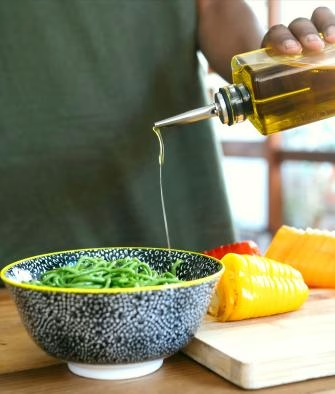There are more than one way to make your own seasoning oil. Today, we’ll introduce two common methods: the “infusion method” and the “heating method.” Everyone should give them a try.
Homemade Seasoning Oil | Cold Infusion Method
The cold infusion method involves infusing ingredients directly into the cooking oil and letting the flavors blend. Here are the steps for making cold infusion oil:
- First, choose your desired cooking oil and the ingredients you want to infuse it with, such as garlic, chili peppers, cilantro, rosemary, etc. While these ingredients can be fresh or dried, we strongly recommend using dried ingredients to minimize bacterial growth. The oil-to-ingredient ratio can be adjusted freely; a 7:1 or 5:1 ratio is common.
- (This step can be omitted if using dried ingredients.) After washing fresh ingredients, it is recommended to air dry them for at least two days before use. Wet ingredients, such as garlic, can also be slowly dried in the oven at around 90°C. The drying time takes about 30 minutes to an hour.
- Each ingredient has a different water content, so it’s recommended to check the water content as you bake. Since everyone’s oven is different, you’ll need to experiment to determine the correct baking time. While drier ingredients prevent bacterial growth, there’s no need to obsess over drying them completely. As long as you refrigerate the prepared oil, you won’t have to worry.
- (This step can be omitted if using dried ingredients.) If you’re using fresh herbs that tend to fade, such as mint or basil, you can first blanch them in hot water to lock in the color and minimize the amount of staining the oil. If you’re using stronger fresh herbs, such as rosemary or thyme, you can also blanch them in hot water to soften them slightly, allowing the flavor to dissolve more easily. Fresh herbs that don’t fade easily, such as cilantro and cilantro, don’t need to be blanched; simply wash and dry them.
- Cut the ingredients, for example, by halving garlic or cutting rosemary into long sections, to allow the flavor to absorb more easily.
- Take a sterilized, airtight glass jar or bottle, place the prepared ingredients inside, then add cooking oil and seal. If your ingredients are too light or too fine to float on the surface of the oil, use a spoon to press the leaves down into the oil before sealing to prevent mold.
- After sealing the seasoning oil, store it indoors in a sunny or warm place to allow the flavor of the ingredients to dissolve more quickly.
- The seasoning oil is ready after sealing for only one day and should be stored in the refrigerator. While the longer the seal is kept, the more pronounced the flavor, the shorter the shelf life in the refrigerator, so avoid leaving it sealed for too long before opening.
Homemade Seasoning Oil | Heating Method
The heating method involves heating the desired cooking oil and ingredients in a pot. This method allows the seasoning oil to last longer than the cold-infuse method. To make seasoning oil using the heating method, follow these steps:
- First, select the oil and ingredients you want to use and follow steps 1 and 2 of the cold-infuse method. Make sure the ingredients are as dry as possible to prevent them from splattering when added to the hot oil.
- Place the cooking oil and ingredients in a pot and heat over medium-low heat for 5-10 minutes. Be careful not to bring it to a boil, so reduce the heat once the oil begins to bubble.
- Remove the pot from the heat and pour the seasoning oil into a clean bowl to cool.
- Sieve the cooled seasoning oil into a sterilized, airtight glass jar or bottle and refrigerate. It will keep for about two weeks.


Leave a Reply